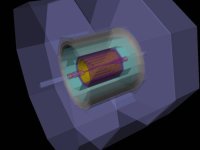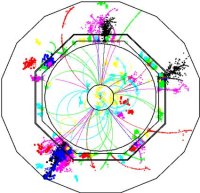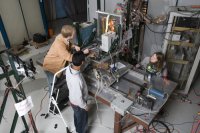 |
 |
|||||||||||||
|
|||||||||||||
|
|||||||||||||
|
The cacophonous tune of cicadas serenaded the physicists at last week’s Department of Energy and National Science Foundation review of the US Detector R&D Programme for the International Linear Collider. Harry Weerts, the High Energy Physics Director at Argonne National Laboratory, where the review took place, vividly remembered the last time the cicadas visited --17 years ago when another detector milestone was in the making. “I remember it well because we were commissioning the DZero detector at Fermilab,” he said. “I’m looking forward to the next time the cicadas come around and seeing what the world looks like then.” Envisioning the worldwide ILC detector programme 17 years from now is on many scientists' minds at the moment and one of the reasons for holding such a review. The World Wide Study, the international body that coordinates ILC detector work in all three regions, recently proposed that the International Linear Collider Steering Committee (ILCSC) make a call soon for Letters of Intent to be submitted in a little over a year from now. These Letters of Intent would be backed by design reports to propose candidates for the two detector designs for the ILC. Working within this proposal, the international community aims to select two detector designs by the end of 2008 to support for completed engineering designs by 2010, keeping with the timeline for the accelerator. Contemplating milestones like these made this particular review not so typical. While the review panel did evaluate the current R&D efforts, their focus was not to critique but rather to help determine a future plan that will make the U.S. detector community a strong partner to the existing programmes in Asia and Europe. “We need to maintain a detector programme in the US that is comparable to the R&D efforts in Asia and Europe,” said Jim Brau of the University of Oregon and co-chair of the American Linear Collider Physics Group (ALCPG). “A review like this is a good exercise to help us identify what we are weak on but also call attention to what we are doing well.” The review panel recognised the tremendous amount of progress made in the US detector R&D programme and offered recommendations on areas that may require further development. One critical need that the reviewers recognised for the detector R&D is the availability of suitable test beams. The Fermilab test beam plays centrally in the plans for the US programme, as well as that of the other regions. A concern is the uncertain future of the SLAC high energy electron test beam, a unique capability of special relevance to the ILC. “Beams tests are a critical ingredient for making informed decisions when designing the ILC detectors,” said Jae Yu of the University of Texas at Arlington who presented at the review. “Test beam facilities for the ILC are becoming very scarce though, and we need to be prepared for a large influx of requests.” Particle flow is another area that the review panel found very promising but needing further development. Research has already suggested that particle flow algorithms, a method of precisely measuring the energies of all the particles produced in an event, can work. The complicated nature of the algorithm, however, makes it difficult to tune and optimise - translation: more manpower needed. While providing an update on software development progress at the review, SLAC's Norman Graf pointed out how limited manpower has an impact on improving existing algorithms and creating new ones. “Our motto is if you can describe it, we can simulate it,” he said. “The lack of manpower, however, limits results.” Members of the review panel suggested that the DOE and NSF consider creating more incentives for young people to join the field, such as developing a fellowship that allows a postdoc to split time between the ILC and other ongoing experiments. The lack of manpower is not necessarily because of a lack of interest though. In fact, several physicists at the review recalled turning away graduate students within the last year because of limited funding. Manpower needs dominate the requested U.S. detector R&D programme budget for FY08 to FY12, of slightly more than $100 million. Weerts presented the 5-year plan for the R&D programme. “This is the first estimate for the U.S. ILC detector R&D, and the programme has been defined as part of the worldwide effort,” he said. “This year we need a recipe on how to proceed.” The reviewers agreed, also noting the need to define goals, milestones and priorities for the various aspects of the R&D. For the past three years, a portion of the funding for the US detector programme came from an umbrella grant given to the University of Oregon. Other funding came from national laboratories. The umbrella grant runs out this year, and members of the US detector community and the funding agencies are now evaluating how to best proceed. The ALCPG already coordinates the R&D efforts within the US, but the multiple funding structures make it difficult to operate like a laboratory. One option is to create a virtual organisation, like the Global Design Effort, but for the detectors. Brau suggested that the proposed appointment of a Research Director for the global detector community may alleviate some of these issues. The ILCSC has set up a search committee to define such a position, and identify candidates to coordinate the international detector programme. “The research director might appoint regional directors,” Brau said. “But there is no current plan for a management structure in the US. We have to work through the next two years to understand what the right plan is for the US programme.” The DOE, NSF and US detector community will continue to discuss project and funding models through the end of the summer when the next call for project proposals will be made. -- Elizabeth Clements Review talks are available online |
|||||||||||||
| © International Linear Collider |


